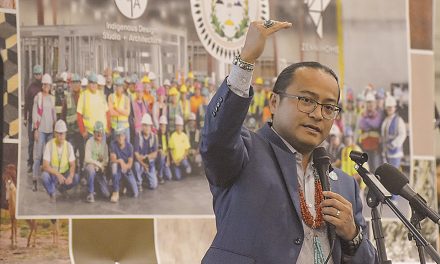
50 Years Ago: An outsider looks at the way the Navajo people lived in 1966
A half century ago, a reporter for the Associated Press spent more than two weeks on the Navajo Reservation talking to some of the 110,000 tribal members who lived on the reservation and came out of the experience extremely impressed with what he had seen.
This would be one of the first major looks at the Navajo as a people and how they were adjusting to the encroachment of a bigger Anglo society. It was, in some ways, a look at the end of one era and the beginning of another on the reservation.
(The Navajo Times, some 10 years later, would use this article as the basis for its own look at how the Navajo people were coping and while 1966 stressed the Navajo people’s reliance on the old ways, the Times articles in 1976 emphasized how the Anglo culture, with its sugar-rich foods, was slowly destroying the ancient ways of the people).
Jules Loh, the writer of the article, first took a look at the lands that the Navajos lived on.
“First Man and First Woman selected a magnificent land for The People,” he wrote. “No wonder they cling to it so.”
In some ways, Loh would say, the land would cast a heavy shadow over the lives of the Navajo. It defined them and although the living standards of the average Navajo could be described as cruel, “the Navajos complain little.”
What he also found was the refusal of the Navajo people “to yield to the inexorable demand of the American melting pot.”
Ten years later, the Times thought that the Navajo people and especially the young Navajos were embracing the Anglo ways too much and were spending more time watching television than they were listening to the grandparents instruct them on the ways of The People.
The 1976 article quoted Navajo leaders who were embracing the Anglo style of living so much that it would cause them health problems, a forewarning of the upcoming diabetes epidemic that would hit the tribal members in the 1990s.
What really impressed Loh, he said, was “their determination to survive as a tribe.”
This was a time when the tribe really started promoting education and as a result, more and more educated Navajos would be leaving the reservation to take jobs in the border communities or in cities like Phoenix, Albuquerque and Salt Lake City.
The Navajo people, said Loh in 1966, want “nothing so much as to preserve their culture, a culture so utterly different that Anglo Americans who have lived among them for years say they are constantly chagrined at how very little about the Navajos they really understand.”
During his stay on the reservation, Loh said he found a few young Navajo women wearing American style clothes. But the predominant fashion on the reservation, for both women and girls, he said, is “long fluted calico skirts, bright velveteen blouses and colorful blankets draped over their shoulders.”
The Navajo men he saw were wearing western garb with broad-brimmed hats, much the way they do today. But Loh said he old-timers still preferred moccasins over western boots and “some still knot their hair in the back.”
Another thing that impressed him, he said, was the habit of both men and women to wear a lot of silver on their person in the form of bracelets, necklaces and rings, even when they were grinding corn or dipping sheep.
“The Navajos have a first rate lumber mill and they own a number of oil wells which they pump with windmills,” he wrote. But the occupation of the average Navajo in 1966 was the same as it was at the turn of the century – raising sheep.
Another thing that has changed since 1966 is the language.
Loh said that Navajo was still the predominant language, although most Navajos speak English. But if you were a tourist and wanted to go to the center of the reservation, you would be wise to bring an interpreter with you.
One of the Navajos he interviewed was Chester Tso Yazzi, a 30-year-old artist, who had been abroad and who had gone to college. At that time he was employed as a sign painter in Flagstaff.
“The religion my children are learning is the Navajo religion,” he told Loh.
That was still true in 1976 as writers for the paper still found a large segment of the Navajo people claiming membership in the Native American Church. The paper at that time pointed out that few of the other religions on the reservation would allow their members to be NAC members and still go to the Anglo churches.
Back in 1966, the way the Navajo approached their daily life was conditioned by the many taboos they learned as children, Loh said.
“They know why the locust doesn’t blink, why the gopher’s tunnel is shallow, why the hogan door must face east, why one must never kill a snake or whistle in the dark or speak another’s name in his presence or laugh during a thunderstorm,” Loh wrote.
In 1976, the Times went to visit a fourth-grade class in Fort Defiance and found that most of the children continued to know these things over things centered around the Anglo culture but no one student knew all of these things.
Loh told a story he was told by a tourist he encountered on his travels through the reservation.
The tourist became friendly with a Navajo family and when they left, the family gave them a ceremonial base they said belonged to their grandfather.
The tourist, of course, asked for the grandfather’s name and his host, Guy Van Winkle, hung his head and mumbled a response, which caused the tourist to ask him to repeat himself.
It was only after the man mumbled a reply again that the tourist realized “that none but a crude white man who doesn’t know good manners would put a Navajo in the position of having to utter a dead person’s name.”
Another area that Loh found to be fascinating was the Navajo view of justice and the growing attempts to have the reservation system adhere to western instead of Navajo values.
For example, Loh said, “a Navajo judge not long ago settled a dispute in favor of a young shepherd girl on the basis of her testimony given to him in private. His decision was not contested. Why? A Navajo child cannot lie when out of the hearing of her parents.”
To read the full article, pick up your copy of the Navajo Times at your nearest newsstand Thursday mornings!
Are you a digital subscriber? Read the most recent three weeks of stories by logging in to your online account.








 Highway 264,
Highway 264, I-40, WB @ Winslow
I-40, WB @ Winslow